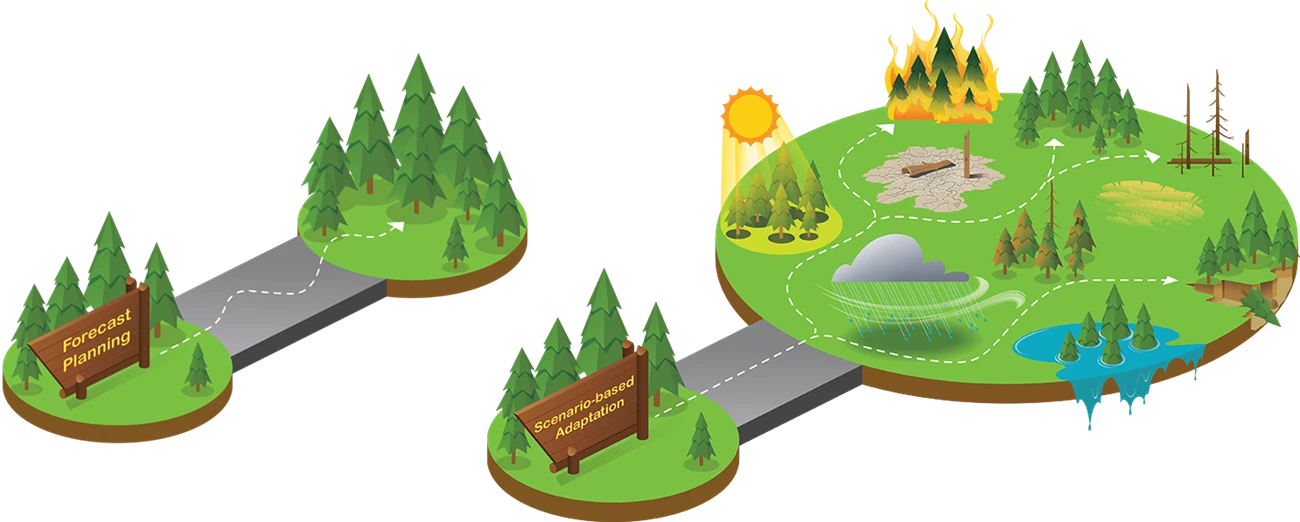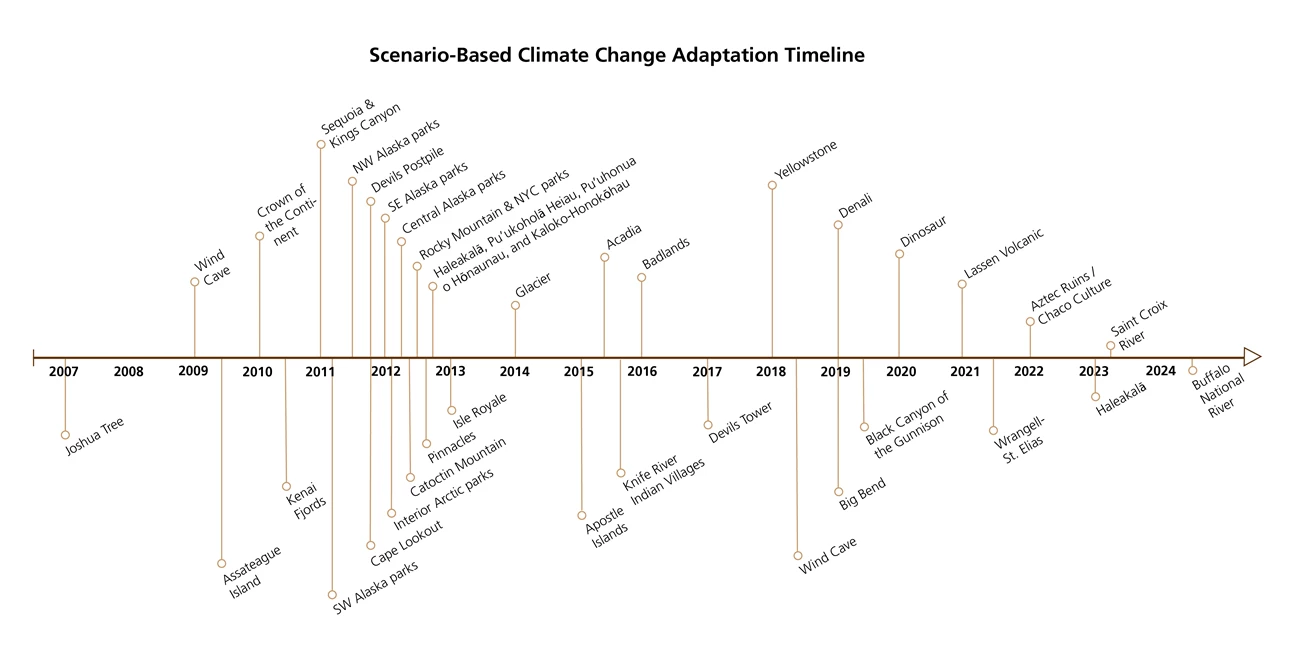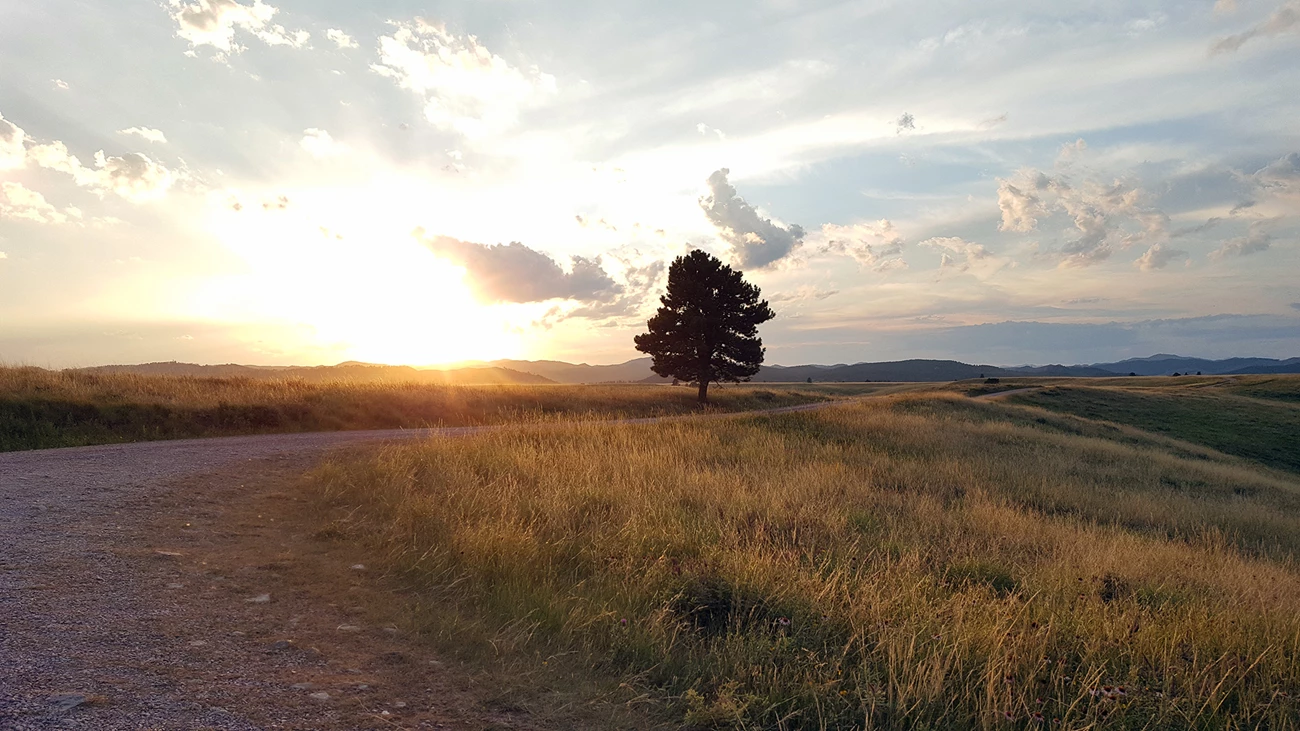What is scenario-based climate change adaptation?
Climate change is having far-reaching impacts on natural and cultural resources, facilities, operations, and the visitor experience. However, parks face a major challenge in anticipating future impacts: not knowing their exact timing and nature. A single forecast is likely to be inaccurate, so it is risky to rely on any one prediction of the future to make management decisions. Scenario planning—a longstanding military and private-sector tool adapted by the NPS and partners in recent years for NPS purposes—addresses this challenge. It offers a framework for working with uncertainty and preparing for a wide range of plausible future conditions. This structured process identifies a small set of scenarios—descriptions of potential future conditions that characterize a broad range of critical uncertainties—and uses them to inform planning. Climate change adaptation that incorporates scenario planning to work with climate uncertainty is known as Scenario-Based Climate Change Adaptation.Scenario-based climate change adaptation vs. forecast planning

NPS image
A useful set of scenarios is plausible (based on best available science), relevant (focused on the management question), divergent (characterizes a range of future conditions), and challenging (effective for examining established practices and assumptions and fostering creative thinking). Working across scenarios, managers can identify:
- current practices likely or unlikely to succeed in the future,
- critical uncertainties around which monitoring or new science could be developed, and
- updated goals or actions that are robust to an uncertain and dynamic future.
How is scenario planning used in climate change adaptation?
Earth's escalating climate crisis requires forward-looking planning approaches that help resource managers work with irreducible and consequential uncertainty. Scenario-based approaches can ground managers in the range of ways climate and resource responses may plausibly play out, help them examine long-held assumptions, and ultimately develop goals and activities that are robust to an uncertain future. Scenario development can be 1) a highly participatory, workshop-based approach that leverages expertise of resource managers and other subject-matter experts, 2) a technical approach in which scientists link climate projections to quantitative models, or 3) something in between. Regardless of format, however, the fundamental objective of scenario-based climate change adaptation planning is to develop insights that inform decision-making and help managers take strategic action.Examples of scenario-based climate change adaptation planning in the NPS
- Wrangell-St Elias National Park and Preserve, 2024. This report summarizes the process used to develop climate-resource scenarios created for resource stewardship. Elements of the scenarios described, including implications for natural and cultural resources, are broadly applicable to other large, protected areas in Alaska and Northwest Canada. Climate-informed management strategies to address these implications are outlined in the following report below.
- Wrangell-St Elias National Park and Preserve, 2024. This report presents climate change-informed resource stewardship strategies for diverse natural and cultural resources. The strategies, developed by park staff and other subject-matter experts in a scenario-based climate change adaptation planning process, address critical climate change implications for park resources identified in an immediately preceding climate-resource scenario development process outline in the preceding report above.
- Lassen Volcanic National Park, 2023. This report summarizes a scenario-based climate change adaptation workshop designed to inform future fire management planning at Lassen Volcanic National Park. The workshop applied scenario thinking to structure discussions about the challenges of climate change and identify climate informed management goals, strategies, and actions.
- Wind Cave National Park, 2021. Wind Cave National Park participated in a project to apply the lessons from a pilot project at a nearby park (Devils Tower National Monument, below) and dovetail scenario-based climate change adaptation with a Resource Stewardship Strategy—a long-range planning tool that helps identify and achieve desired natural and cultural resource conditions in a park.
- White Sands National Park, 2021. A White Sands National Park scenario-based climate change adaptation planning workshop developed and used a set of robust climate-resource scenarios to elucidate key vulnerabilities and critical knowledge gaps that managers and researchers, respectively, can address.
- Devils Tower National Monument, 2019. Devils Tower National Monument participated in a first-of-its-kind, pilot project in 2017 and 2018 to dovetail scenario-based climate change adaptation planning with development of a Resource Stewardship Strategy—a long-range planning tool that helps identify and achieve desired natural and cultural resource conditions in a park.
- Big Bend National Park, 2019. NPS Climate Change Response Program scientists informed a major Big Bend National Park infrastructure investment decision by clarifying the relationship between climate and Oak Spring—the sole water source for visitors in the Chisos Basin—and using a scenario-based approach to characterize long-term reliability of discharge from the groundwater spring.
- Badlands National Park and partners, 2016. A southwest-South Dakota scenario-based climate change adaptation planning workshop, focusing on Badlands National Park and nearby tribal lands and the Buffalo Gap National Grassland, identified priority resource management and climate uncertainties, developed relevant and divergent local climate summaries, and then used them to develop climate-resource scenarios and test management options.
- This project brief summarizes results of a follow-on collaborative effort—involving resource managers, subject-matter experts, and a larger climate change adaptation team—to identify potential climate impacts and management responses in Badlands National Park for priority natural and cultural resources, including bison and black-footed ferrets, the mixed grass prairie in which they live, and historic buildings, trails, and roads.
- Knife River Indian Villages National Historic Site and partners, 2016. A central-North Dakota scenario climate change adaptation planning workshop, focusing on Knife River Indian Villages National Historic Site and nearby tribal and state lands, identified priority resource management and climate uncertainties, developed relevant and divergent local climate summaries, and then used them to develop climate-resource scenarios and test management options.
- Acadia National Park, 2015. An Acadia National Park scenario-based climate change adaptation planning workshop, designed as a training program to increase participants' capabilities to develop and use scenarios, focused on understanding and preparing for climate change impacts on coastal and inland infrastructure, staffing and park operations, and ecosystem management.
- Apostle Islands National Park, 2015. An Apostle Islands scenario-based climate change adaptation planning workshop used regional climate science to craft local scenarios for the park and the surrounding lake (Lake Superior, one of the fastest-warming lakes in the world), to inform both resource management and infrastructure (dock) development.
- Isle Royale National Park, 2013. Isle Royale National Park and partners used scenarios to explore the range of ways in which climate, species interactions, ecosystem processes, and lake conditions might change and ultimately inform a decision to supplement a dwindling population of the island’s first known wolf population, which had inhabited the island since the 1940s.

How can I learn more about scenario-based climate change adaptation and planning?
The following guidance documents and journal publications collectively describe the scenario-based climate change adaptation planning process and illustrate recent NPS-driven evolution. Resource management often presents complex and unique challenges, and the approach presented here is meant to serve as a flexible guide for further application and innovation.
Scenario-based climate change adaptation planning guidance from the NPS
- Planning for a Changing Climate, 2021 is a comprehensive resource to guide climate-smart adaptation planning. The guide helps planners and managers develop forward-looking goals and evaluate strategies and actions in light of multiple plausible futures associated with a changing climate.
- Resource Stewardship Strategy Supplemental Guidance, 2020 provides a repeatable methodology to use scenario-based approaches to address climate change in Resource Stewardship Strategies (strategic plans to help managers to achieve and maintain desired conditions).
- Using Scenarios to Explore Climate Change: A Handbook for Practitioners, 2013 describes the five-step process for developing climate change scenarios and provides detailed instructions on how to accomplish each step of the scenario-building process. A 2014 addendum is also available.
Scenario-based climate change adaptation planning articles from the NPS and partners
- Ecological Scenarios: Embracing Ecological Uncertainty in an Era of Global Change (Ecosphere, 2025)
- Accurately Characterizing Climate Change Scenario Planning in the U.S. National Park Service: Comment on Murphy et al. 2023 (Society & Natural Resources, 2024). This article, which shares the depth and breadth of NPS efforts to streamline and mainstream scenario-based climate change adaptation planning, supplements a recent article on the topic by more accurately locating the boundary between current practice and research priorities in the NPS.
- Scenario-Based Decision Analysis: Integrated scenario planning and structured decision making for resource management under climate change (Biological Conservation, 2023)
- Planning for Future Climates at Wrangell-St. Elias: Mainstreaming Park-Based Actions (Alaska Park Science, 2023)
- Overcoming "analysis paralysis" through better climate change scenario planning (Park Science, 2022)
- Conservation under uncertainty: Innovations in participatory climate change scenario planning from U.S. national parks (Conservation Science and Practice, 2022)
- Divergent, plausible, and relevant climate futures for near- and long-term resource planning (Climatic Change, 2021)
- Repeatable approaches to work with scientific uncertainty and advance climate change adaptation in US national parks (Park Stewardship Forum, 2020)
- Co-producing simulation models to inform resource management: a case study from southwest South Dakota (Ecosphere, 2017)
- Multiple methods for multiple futures: Integrating qualitative scenario planning and quantitative simulation modeling for natural resource decision making (Climate Risk Management, 2017)
- Supporting adaptation decisions through scenario planning: Enabling the effective use of multiple methods (Climate Risk Management, 2016)
Additional resources
- What might happen? How to make the most of scenario planning (training aid, 2022)

Last updated: May 28, 2025
